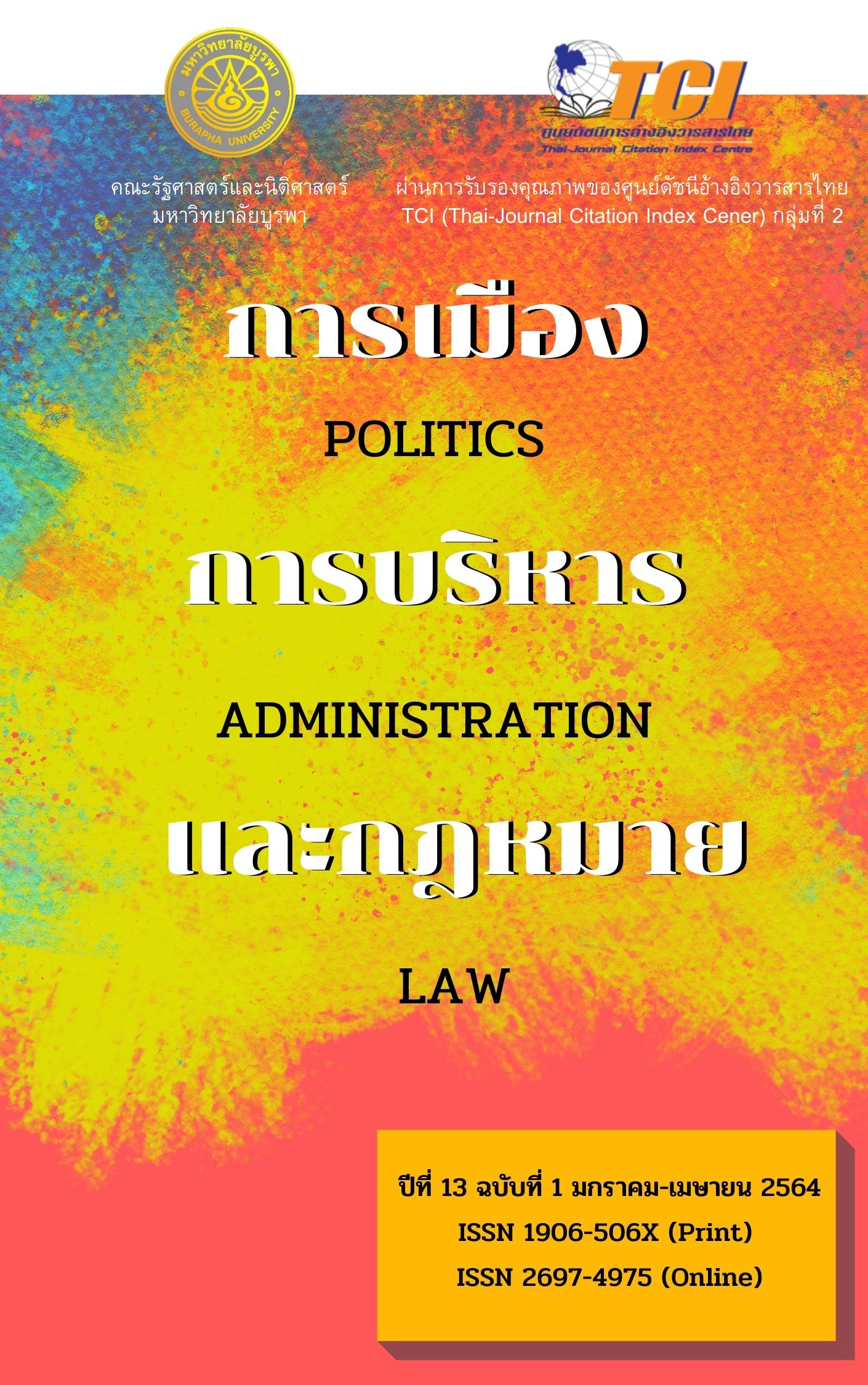การเมืองในองค์การกับการสรรหาและคัดเลือกบุคลากรสายวิชาการ ในสถาบันอุดมศึกษาไทย
คำสำคัญ:
การเมืองในองค์การ, การสรรหาและคัดเลือก, บุคลากรสายวิชาการบทคัดย่อ
การวิจัยนี้มีวัตถุประสงค์ คือ (1) เพื่อศึกษาการเมืองในองค์การที่เกิดขึ้นในการสรรหาและคัดเลือกบุคลากรสายวิชาการในสถาบันอุดมศึกษาไทยและ (2) เพื่อศึกษาผลกระทบของการเมืองในองค์การที่มีต่อการสรรหาและคัดเลือกบุคลากรสายวิชาการของสถาบันอุดมศึกษาไทย โดยใช้การวิจัยเชิงคุณภาพในรูปแบบการวิจัยแบบฐานรากเพื่อนำไปสู่ข้อสรุปทางทฤษฎีและการทำความเข้าใจปรากฏการณ์ที่เกิดขึ้นในประเด็นที่เกี่ยวข้องกับการเมืองในองค์การกับการสรรหาและคัดเลือกบุคลากรสายวิชาการในสถาบันอุดมศึกษาไทย โดยจะใช้วิธีการเก็บรวบรวมข้อมูลที่หลากหลาย ได้แก่ การสัมภาษณ์แบบเจาะลึก การสังเกตแบบไม่มีส่วนร่วมและการศึกษาจากเอกสาร ผู้ให้ข้อมูลสำคัญในการวิจัยครั้งนี้มีทั้งสิ้น 33 ท่าน ใช้วิธีการคัดเลือกแบบลูกโซ่ตามเกณฑ์คุณสมบัติที่กำหนด ข้อเสนอแนะเชิงทฤษฎีจากการศึกษาครั้งนี้มีส่วนในการเพิ่มองค์ความรู้ให้กับวิชาการด้านการบริหารทรัพยากรมนุษย์ ประการแรกพบว่าการเมืองในองค์การที่เกิดขึ้นในการสรรหาและคัดเลือกบุคลากรสายวิชาการในสถาบันอุดมศึกษาไทยมี 3 ลักษณะคือ (1) การใช้อำนาจ (2) การเลือกปฏิบัติอย่างไม่เป็นธรรม (3) การใช้ระบบอุปถัมภ์ การใช้ระบบเส้นสาย ระบบพรรคพวก ประการที่สองพบว่าในการดำเนินกิจกรรมของการสรรหาและคัดเลือกขาดกลไก การผลักดันที่มีประสิทธิภาพส่งผลกระทบได้ทั้งด้านบวกและด้านลบต่อสถาบันอุดมศึกษา ข้อเสนอแนะในทางปฏิบัติอาจนำผลการศึกษานี้ไปประยุกต์ใช้ในหน่วยงานเพื่อกำหนดแนวทางในการรักษาสมดุลทางการเมืองและการพัฒนาแนวทางการสรรหาคัดเลือกที่ก่อให้เกิดประโยชน์สูงสุดแก่สถาบันอุดมศึกษาต่อไป
เอกสารอ้างอิง
พรพรรณ เหมะพันธุ์ และทิพวรรณ หล่อสุวรรณรัตน์. (2561). How to Be the Best: The case of the National University of Singapore. วารสารสภาคณาจารย์ สถาบันบัณฑิตพัฒนบริหารศาสตร์ Wisdom Faculty Senate, 19, 3-11.
ปิยวัฒน์ แก้วกัณฑรัตน์. (2550). การบริหารความเสี่ยงด้านทรัพยากรบุคคล, รายงานประกอบโครงการพัฒนาระบบ การบริหารความเสี่ยงด้านทรัพยากรบุคคล. กรุงเทพฯ: สำนักงานคณะกรรมการข้าราชการพลเรือน.
สุภาพร พิศาลบุตร. (2550). การวางแผนและการบริหารโครงการ (Planning and project management). กรุงเทพฯ: ศูนย์หนังสือมหาวิทยาลัยราชภัฏสวนดุสิต
Amos, T. L., Ristow, A., Ristow, L., & Pearse, N. (2008). Human Resource Management (3rd ed.). Cape town: Juta
Byars, L. L., & Rue, L. W. (1987). Human Resource Management. Homewood.IL: Irwin.
Chung, K. H., & Megginson, L. (1981). Organization behavior: developing management skill. New York: Harper & Harper.
Collins, C. J., & Smith, K. G. (2006). Knowledge exchange and Combination: The role of human resource practice in the performance of high technology firms. The Academy of Management Journal, 49(3), 544-560.
Daft, R. L. (2001). Organization theory and design (7th ed.). Mason, OH: South-Western.
Daniel, C. (2008). The educational attributes of some of the World’s Top 50 University. Australia: The University of Western Australia.
DuBrin, A. J. (1998). Leadership Research Findings, Practice, and Skills. Boston: Houghton Mifflin.
Ferris, G. R., & Judge, T. A. (1991). Personnel/ Human Resources Management: A political influence perspective. Journal of Management, 17(2), 447–488.
Harris, M. (2000). Human Resource Management: A Practical approach (2nd ed.). Orlando, FL: Harcourt.
Heneman, H. G., Schwab, D. P., Fossum, J. A., & Dyer, L. D. (1980). Personnel/ Human Resource Management. Homewood, IL: Irwin.
Heneman H. G., & Judge, H. G. (2009). Staffing Organization (6th ed.). New York: MaGraw-Hill Education.
Ivancevich, J., Mathis, R., & Jackson, J. (2004). Human Resource Management. Stamford, USA: South Western Cengage Learning.
Madison, D. L., Allen, R. W., Porter, L. W., Ronvick, P.A., & Mayes, B. T. (1980). Organizational politics, An Exploration of Managers’ perception. Human relation, 33(2), 79-100.
Marasco, J. (2004). On Politics in Technical Organizational. Retrieved March 6, 2020, from http://www.128.ibm.com/developerworks/rational/library/4690.html
Miles, M. B., & Huberman, A. M. (1994). Qualitative data analysis. An expanded sourcebook (2nd ed.). Thousand Oaks, CA: Sage.
Nabi, G., Wei, S., Husheng, X., Shabbir, M., Altaf, M., & Zhao, S. (2014). Effective Recruitment and Selection Procedures: an Analytical study based on Public sector University of Pakistan. Public Policy and Administration Research, 4(10), 12-21.
Phonemajedy, R., & Treputtharat, S. (2555). The Existing in Faculty of Education National University of Laos. Laos: National University of Laos.
Schuler, R. S. (1984). Personnel and Human Resource Management (2nd ed.). New York, NY: West.
Shermerhorn, J. R., Hant, J. G., & Osborn, R. N. (2000). Organization behavior (7th ed.). New York: Von-Hoffman.
Stredwick, J. (2001). An introduction to human resource management. London: Routledge, Taylor & Francis Group.
Taylor, S., & Woodham, C. (2012). Managing People and Organisations. London, United Kingdom: McGraw-Hill Education.
Thebe, T. P., & Waldt, G. V. D. (2014). A recruitment and selection process model: the case of the Department of Justice and Constitutional Development. Administratio Publica, 22(3), 6-29.
Vigoda, E. (2003). Rethinking the identity of public administration: Interdisciplinary reflections and thoughts on managerial reconstruction. Public Administration and Management, 8(1).
Vigoda, E., & Cohen, A. (2002). Influence tactics and perceptions of organizational politics: A longitudinal study. Journal of Business Research, 55(4), 311–324.
Yaseen, A. (2015). Performance management practices and its impact on Banks’ performance in Pakistan. International Journal of Human Resource Studies, 5(4), 110-127.
Yukl, G., & Falbe, C. M. (1990). Influence Tactics and Objectives in Upward, Downward, and Lateral Influence Attempts. Journal of Applied Psychology, 75(2), 132-140.
ดาวน์โหลด
เผยแพร่แล้ว
ฉบับ
ประเภทบทความ
สัญญาอนุญาต

อนุญาตภายใต้เงื่อนไข Creative Commons Attribution-NonCommercial-NoDerivatives 4.0 International License.






